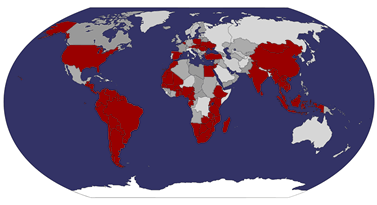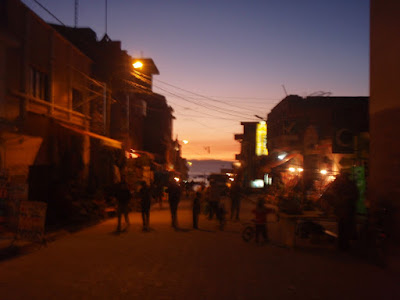For those of you who are regular readers, you realize by now that Bolivia was tough for us at times. It was a confounding mix of beautiful and difficult. However, as with most places, life became much easier when you took people out of the equation. So, we set out to Rurrenabaque, right on the edge of the rainforest, where wildlife is plentiful and people are few.
It is worth noting that it was this same bus for which we were waiting when our bag was stolen. I left Tara at the station holding on to our bags with another American couple while I went to see if I could buyback any of my stuff in the local market (didn't find any), and three older men tried to steal their bags. Fortunately, Tara was quick to grab them before they could get them. Unfortunately, she wasn't quick enough to kick any of them in the head before they ran away...
Okay, now to the pictures. The bus ride to Rurrenabaque is 18 hours despite only being about 180 miles away. It doesn't take much math to figure out that it should be about the same speed to take a donkey. However, we don't know much about caring for donkeys, so we took the bus. It travels down the "world's most dangerous road", which may or may not actually be the most dangerous. (This motto is mostly used by mountain bike companies taking trips there, but the road seems to be much less dangerous on a bike than in a vehicle.) The road is mostly along cliffs with almost no shoulder and no guard rails. Additionally, some brilliant lawmaker in Bolivia decided that the vehicle going down the cliff should always be on the edge. Here's the view:

The mountains were lovely, and as we got to lower altitudes, they started to be very green as well with waterfalls and all the stuff that you would expect when driving to a rainforest.

Once we got to Rurrenabaque, we managed to book a last minute tour with a decent seeming company for a really good price. Additionally, they read us really well and offered up free use of showers for the two hours until the tour left. We had been on back to back overnight buses, so we were sold. Two hours later, we set out for the Bolivian Pampas, which is the grasslands bordering the rainforest. It is easier to see animals here than in the forest because they have no trees in which to hide. On the way, we saw dinner.

We stopped for lunch at a restaurant that seemed to have some quasi-pet animals from the area. This guy is a peccary, which is very much like a pig in looks and actions, but isn't actually related to one. Hard to tell his size, but he is the size of a pig and he walked right under our table and laid down until someone shooed him off.

Tara loves peccaries. Had there been baby peccaries, we would no doubt have one in our backpack. This one was too big to keep, though.

This jabiru also stopped by for a visit. These birds are about five feet tall and don't take kindly to strangers getting very close. One had a huge nest right above our camp site, but none of our pictures of that one were nearly as good.

This spider monkey took a liking to one of the other guys in our group and then to me. They have a prehensile tail that they use like a fifth arm and they are very strong. This monkey seemed really friendly, but then started chewing on one of the girls. It decided it didn't like me anymore after I pulled him off the girl (she was fine--the monkey was just biting her lightly).

After it bored of playing with the tourist, it was ready for a ride.

To get to camp, we took a three hour boat ride down the river. Because it is the very end of dry season, the river is at nearly its lowest point of the year. This means all the animals come to the river for water because the local watering holes are dry.

We saw a troop of squirrel monkeys (they live in groups of about 30-50) and one brave one even came to board the boat. He left in anger when no one would feed him.

All the caimans and crocodiles (they apparently have black caimans and then some species of croc here) come to the river at this time of year. They are everywhere. They eat anything, including other crocs. We saw them from about a foot long to about 15 feet long. It was great when they stopped the boat and told us it was time to take a swim.

The real reason that we went to this area is to see capybaras, the biggest of the rodents. These rats can grow to 180 pounds and are huge. We were worried we might not see any, which turned out to be silly. We saw hundreds. Everytime we saw one with babies, Tara took a picture. They bathe in the mud at the edge of the river to stay cool and insect free (and to sometimes feed the crocs).

This one seems to be waiting for us to come get in the boat. I let Tara get in first.

One morning we spent four hours hiking around looking for anacondas. The downside of dry season is that many of the marshy areas where anacondas live dry up, so they run away. The guides tried hard to walk through the mud poking around for a giant snake, but no luck. The best I could do was some colorful fungus. We ran into another group that had seen one, so our group tied them up in jealousy and left them there to see some more anacondas.

A blurry sunset over the pampas. These are grasslands, but the grasses grow to about four feet high. We walked through a lot of it looking for snakes, and it isn't what you think of when you think grass. It's like Little Shop of Horrors grass.

We also went pirana fishing. Again. For those who don't remember, we tried this in the Amazon and caught nothing. This time, at least there were piranas, but they were tiny. I couldn't even get this one to bite off my nose.

The only bird that seemed fearless was this tiger heron. A really nice looking bird. He is suppose to eat fish, but given how unafraid this one was, I suspect he eats a lot of leftovers as well.

Here is a whole herd of capybaras rushing out of the water as we passed by. Okay, herd probably isn't the right word for a group of capybaras. I actually did some reseach just now, and no one seems to know. A BBC article also calls them herds, so I'm going to say what I usually say--I was right.

That brings our exciting time in Rurrenabaque to an end. I should say that we also finally saw pink river dolphins, which were really cool. They went back under too fast to ever get pictures of them, but it is the areas patrolled by these dolphins where it is safe to swim. They will not let crocs swim in the same water as them and they can be ferocious in their defense of territory.
After several nice days in the wilderness, we got back on the very slow overnight bus and went back to La Paz. We left La Paz as soon as we could and decided that we would deal with not having Bolivian visas because of stolen passports when we got to the border. So, we exited at the same Bolivian crossing where we entered.
The guy was nice enough and found our entry visa information in about 30 seconds. Then he looked at us and said, "You need to get a new visa stamp in La Paz. I'm not able to do it here." We told him all we needed was an exit stamp and he clearly had proof of our legal entry. And that we weren't going back to La Paz (4 hours away). He finally agreed to let us just leave with no stamp. So, we practically ran the 500 feet to Peru before he changed his mind.
The woman at the Peru border looked at our fresh passports and said that she could not let us in without an exit stamp from Bolivia. We told her the whole story and she reiterated that we absolutely must have an exit stamp from Bolivia. We said that we could not go back and asked if there was
any way to get into Peru. After a moment, she decided that we could pay a $20 "fee" and the problem would go away. So, it surprised us, but we did not have to bribe our way out of Bolivia and instead bribed our way into Peru.
That wraps up our Bolivian adventures. It was a decent country, and is really cheap, but the culture is really difficult to adjust to. We have met many travelers who say that Bolivia is their favorite country. That definitely isn't true for us, but we certainly will keep some nice memories from parts of it.
 We only stayed a few hours at the lines and then on to Lima, the capital of Peru and a city of almost 8 million people. Lima is mostly a gray and dirty town. However, parts of it are really nice. We stayed at Hostal Espana, which we recommend. Here is a picture of the atrium.
We only stayed a few hours at the lines and then on to Lima, the capital of Peru and a city of almost 8 million people. Lima is mostly a gray and dirty town. However, parts of it are really nice. We stayed at Hostal Espana, which we recommend. Here is a picture of the atrium. As soon as we were settled in, we went in search of street food. The street food in Lima is excellent and will be covered in the food post. So, you get the dregs. Boring things like buildings. Here is the main cathedral at night. Pizarro is "buried" here in a glass case, we hear. We were unwilling to pay the $7 to see it in person.
As soon as we were settled in, we went in search of street food. The street food in Lima is excellent and will be covered in the food post. So, you get the dregs. Boring things like buildings. Here is the main cathedral at night. Pizarro is "buried" here in a glass case, we hear. We were unwilling to pay the $7 to see it in person. We went to visit the free Inquisition museum. They went on a lot about how terrible it was, but based on my knowledge of the European Inquisition, Peru had it easy. Really only a couple of standard torture techniques. Here they show you the rack. The Peruvian inquisitors couldn't even spring for a real rack. They had to make one on the cheap.
We went to visit the free Inquisition museum. They went on a lot about how terrible it was, but based on my knowledge of the European Inquisition, Peru had it easy. Really only a couple of standard torture techniques. Here they show you the rack. The Peruvian inquisitors couldn't even spring for a real rack. They had to make one on the cheap.
















































































